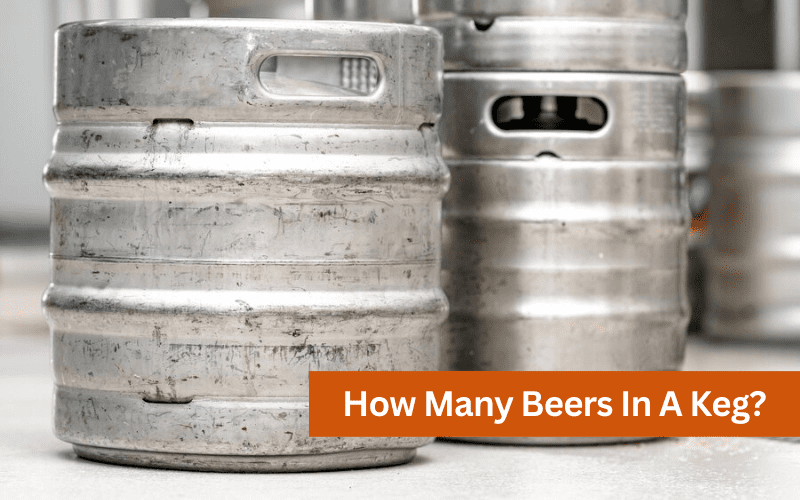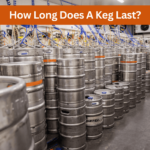The question of how many beers in a keg is one that every beer lover has asked at some point in their lives. Whether you’re throwing a party, hosting a wedding reception, or just looking to stock up for a big game, knowing how much beer to buy can be a real challenge.
As a seasoned beer enthusiast, I’ve had my fair share of keg-related mishaps, from running out of beer too soon to overbuying and ending up with a fridge full of stale brew. That’s why I’m excited to share my knowledge and experience with you in this comprehensive guide to understanding keg sizes and how many beers in a kegerator. So grab a cold one and let’s get started!
Understanding Keg Sizes
Understanding keg sizes is an important aspect of serving beer. There are various keg sizes available in the market that can hold a different number of beers. Each keg size has its advantages and disadvantages, making it essential to choose the right keg for your specific needs.
Here are seven different keg sizes that you should know about:
- Cornelius Keg
- Sixth Barrel Keg
- Quarter Barrel Keg, also known as a “Pony Keg”
- Slim Quarter Keg
- Half Barrel Keg
- 50 Litre Keg
- Mini Keg
Knowing about these keg sizes is essential when purchasing a keg or planning an event. Understanding keg sizes can help you determine the appropriate keg size for your specific needs, ensuring that you have enough beer to serve your guests without wasting any.
How Many Gallons in a Keg?
The number of gallons in a keg varies depending on the size of the keg. Here are the most common keg sizes and their corresponding gallons:
- Sixth Barrel Keg – This keg size can hold up to 5.16 gallons of beer.
- Cornelius Keg – 5 gallons
- Quarter Barrel Keg – This keg size is also known as a pony keg and can hold up to 7.75 gallons of beer.
- Slim Quarter Keg – As the name suggests, a Slim Quarter Keg is a taller and slimmer cousin of a Quarter Barrel Keg, holding the exact same amount of beer as the latter, which is 7.75 gallons.
- Half Barrel Keg – This keg size is the most common in the US and can hold up to 15.5 gallons of beer.
- 50 Litre Keg – This keg size is popular in Europe and can hold up to 13.2 gallons of beer.
- Mini Keg – This keg size is small and portable and can hold up to 5 liters or 1.32 gallons of beer.
Knowing the gallons in each keg size is essential when purchasing or renting a keg, as it determines the amount of beer it can hold and the number of people it can serve.

How Many Beers in a Kegerator?
If you’re wondering how much beer is in a keg, the answer depends on the size of the keg
How many beers are in a half keg?
How many beers in a keg standard? A half keg can hold up to 165 12-ounce cans or bottles of beer. A half keg is also known as a “full size” keg, and it is the most common keg size used in the US.
How many beers are in a quarter keg?
So, how many beers in a pony keg? A quarter keg, also known as a pony keg, can hold up to 82 12-ounce cans or bottles of beer.
A quarter keg is a popular keg size for small gatherings and parties, as it holds a significant amount of beer without taking up too much space. It is also portable and can be easily transported to different locations. So, now you know how many beers in a 1 4 keg and can decide whether it’s suitable for your party or not.
How many beers in a sixtel?
How many beers in a keg sixtel? A sixtel, also known as a sixth barrel, can hold up to 56 12-ounce cans or bottles of beer. A sixtel is a popular keg size for small events or personal use, as it holds a smaller amount of beer compared to larger keg sizes like half-barrel or quarter-barrel kegs. It is also easy to transport and store, making it a convenient option for those who have limited space.
How many beers in a slim keg?
There are two keg sizes referred to as “slim kegs,” the slim quarter keg and the slim sixth keg.
The slim quarter keg is similar to the quarter keg in terms of capacity, but it has a taller and slimmer design, making it easier to store. It can hold up to 82 12-ounce cans or bottles of beer. On the other hand, the slim sixth keg is a smaller keg size, which can hold up to 42 12-ounce cans or bottles of beer.
Both slim keg sizes are popular for small events and personal use. When using a slim keg, it is essential to consider the number of guests and the amount of beer they are likely to consume to avoid running out of beer. It is also important to ensure that your kegerator or beer dispensing system is compatible with the specific slim keg size you’re using.
How many beers in a corny keg?
A corny keg, also known as a cornelius keg, can hold up to 40 12-ounce cans or bottles of beer. Corny kegs are small keg sizes that are popular among homebrewers and those who want to dispense their beer. They are easy to use, clean, and maintain. Additionally, they can be stacked and stored easily, making them convenient for home use.
How many beers in a 50 litre keg?
A 50-liter keg can hold up to 140 12-ounce cans or bottles of beer. The 50-liter keg is a popular keg size used in Europe, and it is slightly larger than the standard half-barrel keg used in the US. It is commonly used in bars and restaurants, as well as for large events and parties.
How many beers in a mini keg?
A mini keg, also known as a “bubba keg,” can hold up to 14 12-ounce cans or bottles of beer. Mini kegs are small and portable, making them perfect for personal use and small gatherings. They are typically made of metal or plastic and can be pressurized using a CO2 cartridge or a hand pump.
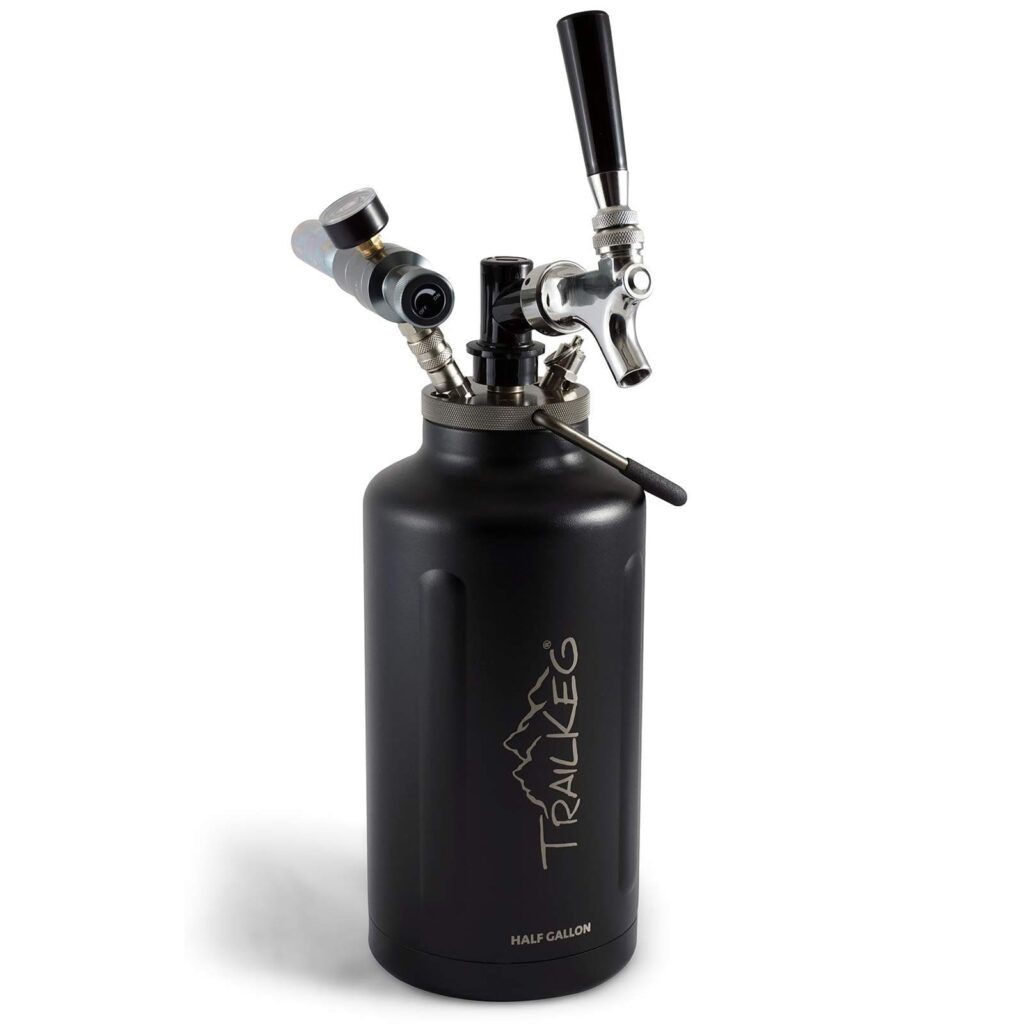
How Many Ounces in a Keg?
Here’s a table that shows the number of ounces in each keg size:
| Keg Size | Ounces |
| Sixth Barrel Keg | 661 oz |
| Cornelius Keg | 640 oz |
| Quarter Barrel Keg | 992 oz |
| Slim Quarter Keg | 992 oz |
| Half Barrel Keg | 1984 oz |
| 50 Liter Keg | 1691 oz |
| Mini Keg | 169 oz |
How Many Pints in a Keg?
Here’s how many pints are in each keg size:
- Sixth Barrel Keg: 42 pints
- Cornelius Keg: 40 pints
- Quarter Barrel Keg: 62 pints
- Slim Quarter Keg: 62 pints
- Half Barrel Keg: 124 pints
- 50 Liter Keg: 106 pints
- Mini Keg: 11 pints
How Many Cases of Beer in a Keg?
The number of cases of beer in a keg depends on the size of the keg and the size of the beer case. Here are some common case and keg sizes and the corresponding number of cases in a keg:
- 12-ounce cans: A half barrel keg (15.5 gallons) can hold up to 6.9 cases of 24-pack cans or 7.75 cases of 18-pack cans. A quarter barrel keg (7.75 gallons) can hold up to 3.5 cases of 24-pack cans or 3.9 cases of 18-pack cans.
- 16-ounce cans: A half barrel keg (15.5 gallons) can hold up to 5.2 cases of 24-pack cans or 5.8 cases of 18-pack cans. A quarter barrel keg (7.75 gallons) can hold up to 2.6 cases of 24-pack cans or 2.9 cases of 18-pack cans.
- Bottles: The number of cases of beer in a keg of bottles varies depending on the size of the bottle. For example, a half barrel keg (15.5 gallons) can hold up to 4.6 cases of 12-pack bottles, 3.5 cases of 15-pack bottles, or 3.1 cases of 18-pack bottles.
It is essential to consider the type of beer, keg size, and bottle or can size when calculating the number of cases of beer in a keg.
How Many Litres in a Keg?
Understanding how many liters a keg holds is important for purchasing or renting the right keg for your needs. Here’s a table that shows the number of liters in each keg size:
| Keg Size | Liters |
| Sixth Barrel Keg | 20 L |
| Cornelius Keg | 18 L |
| Quarter Barrel Keg | 30 L |
| Slim Quarter Keg | 30 L |
| Half Barrel Keg | 59 L |
| 50 Liter Keg | 50 L |
| Mini Keg | 5 L |
As shown in the table, a Sixth Barrel Keg holds 20 liters of beer, while a Cornelius Keg holds 19 liters. A Quarter Barrel Keg and a Slim Quarter Keg both hold 30 liters of beer. A Half Barrel Keg holds 59 liters, and a 50 Liter Keg holds 50 liters of beer. Lastly, a Mini Keg holds 5 liters of beer.
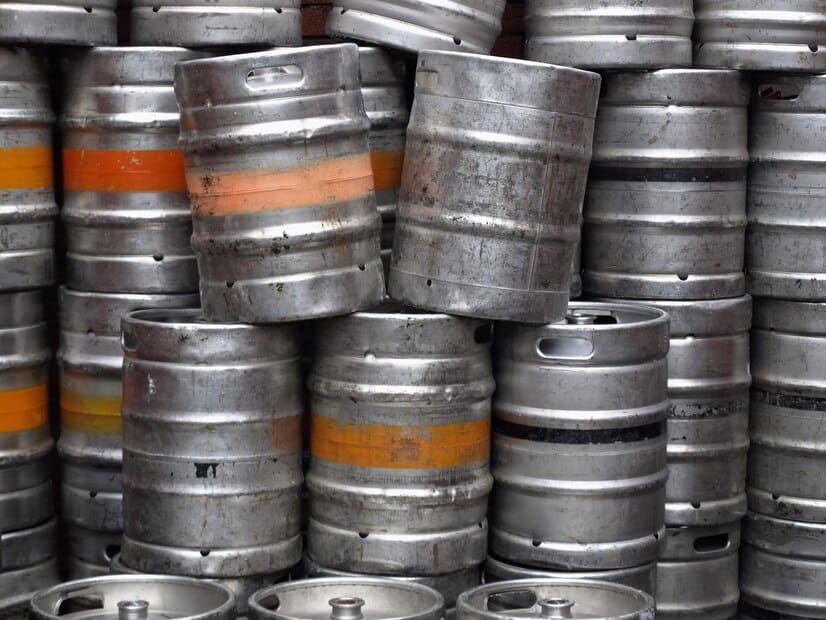
How Many Beers in a Heineken Mini Keg?
The Heineken mini keg contains 5 liters of beer, which is equivalent to 169 ounces. Assuming a standard serving size of 12 ounces, there are approximately 11 pints in a Heineken mini keg.
How Many Ounces in a Keg of Bud Light?
A keg of Bud Light can come in different sizes, but the most common size used in the US is a half-barrel keg, which holds 15.5 gallons or 1984 ounces of beer. A standard serving of Bud Light is 12 ounces, which means that a half-barrel keg can serve approximately 165 12-ounce servings or 124 pints of beer.
How Many Glasses of Beer in a Keg?
Here’s an approximate calculation of the number of glasses of beer in each keg size based on a standard glass size of 16 ounces:
- Sixth Barrel Keg: 42 glasses
- Cornelius Keg: 40 glasses
- Quarter Barrel Keg: 62 glasses
- Slim Quarter Keg: 62 glasses
- Half Barrel Keg: 124 glasses
- 50 Liter Keg: 106 glasses
- Mini Keg: 21 glasses
It is important to note that this calculation is an approximation and can vary depending on the actual glass size and how much head (foam) is poured into each glass. It is also important to consider the number of guests, their drinking habits, and how much beer you plan to serve per person when choosing the keg size.
How to Choose the Right Keg Size
Choosing the right keg size is crucial when planning an event or purchasing a keg for personal use. Here are some factors to consider when selecting the right keg size:
- Number of guests: The number of guests you plan to serve is an essential factor when choosing a keg size. A general rule of thumb is to plan for approximately two 12-ounce servings of beer per guest.
- Drinking habits: Consider the drinking habits of your guests. If your guests are moderate drinkers, you may need less beer per person. However, if they are heavy drinkers, you may need more beer per person.
- Event duration: The length of the event is also an important factor. For longer events, you may need a larger keg size, while shorter events may require smaller kegs.
- Beer preference: The type of beer you plan to serve can also affect the keg size you need. Some beers may be more popular than others, and you may need a larger keg size to accommodate the demand.
- Refrigeration: Consider the storage space you have available for the keg, and whether you have the proper refrigeration equipment to keep the keg at the ideal temperature.
- Budget: Kegs come in different sizes, and the price varies depending on the keg’s size. Consider your budget and how much you are willing to spend on a keg.
- Special occasions: For special occasions like weddings, graduations, and other big events, consider purchasing multiple kegs to accommodate different types of beers and preferences.
By considering these factors, you can choose the right keg size that can cater to your guests’ drinking needs and make your event a success.
Understanding Keg Materials
Kegs are an essential part of the beer dispensing process, and they come in different materials. Understanding the various keg materials can help you choose the right keg for your needs. Here are some of the most common keg materials:
- Stainless steel: Stainless steel is the most popular material used for kegs. It is durable, easy to clean, and can withstand high pressure. Stainless steel kegs are also reusable and can be recycled.
- Aluminum: Aluminum kegs are lightweight and easy to handle. They are resistant to corrosion, making them suitable for outdoor use. Aluminum kegs are also recyclable.
- Plastic: Plastic kegs are the most affordable option and are commonly used for smaller kegs. They are lightweight and can be stacked for easy storage. Plastic kegs are also recyclable.
- Glass: Glass kegs are the least common keg material due to their fragility. They are not suitable for high-pressure beer dispensing and are mainly used for homebrewing and small-scale events.
When choosing a keg material, consider the type of beer you plan to serve, the event location, and the storage and handling conditions. Stainless steel is the most versatile and durable keg material and is suitable for most beer types and events.
Aluminum kegs are ideal for outdoor events and are more lightweight than stainless steel. Plastic kegs are affordable and can be a good option for small-scale events, while glass kegs are suitable for homebrewing and small events.
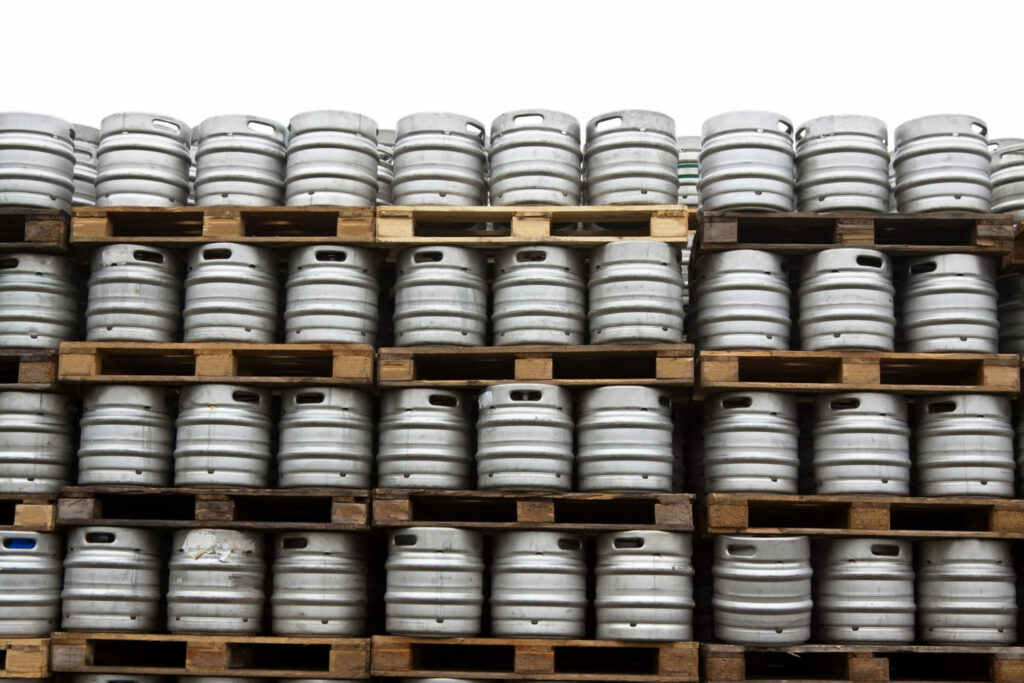
Read also: How Much Does A Keg Weigh?
Keg Maintenance and Storage
Proper keg maintenance and storage are crucial to ensure the quality and freshness of the beer inside the keg. Here are some tips for keg maintenance and storage:
- Keep the keg refrigerated – Beer kegs should be stored at a temperature between 32-38°F to maintain the beer’s quality and freshness.
- Check the CO2 pressure – The CO2 pressure should be set at the proper level to maintain the carbonation of the beer. A pressure gauge can be used to adjust the CO2 pressure to the recommended level.
- Clean the keg regularly – Kegs should be cleaned and sanitized regularly to prevent bacteria and mold growth that can affect the beer’s taste and quality.
- Inspect the keg for damage – Before use, inspect the keg for any visible damage or leaks. A damaged keg can cause beer to spoil and waste.
- Handle the keg with care – Kegs are heavy and should be handled with care to avoid any damage. Always lift and move kegs using a keg lifter or hand truck.
- Use the keg within the recommended time frame – The shelf life of beer in a keg can vary depending on the type of beer and storage conditions. Check the manufacturer’s recommendation for the recommended time frame to use the beer in the keg.
By following these keg maintenance and storage tips, you can ensure the quality and freshness of the beer inside the keg and provide a great tasting and enjoyable drinking experience for your guests.
How Long Does Beer Last In A Keg?
The lifespan of beer in a keg depends on several factors, such as the dispensing method and whether the beer is pasteurized or not. For non-pasteurized beer dispensed with CO2, the general rule of thumb is that it can retain its freshness for 45-60 days, provided that the keg is stored and maintained at the proper pressure and temperature. On the other hand, pasteurized draft beer can last for around 90-120 days.
Note that these estimates are just guidelines and that the actual lifespan of beer in a keg can still vary depending on other factors, such as the specific beer brand and storage conditions.
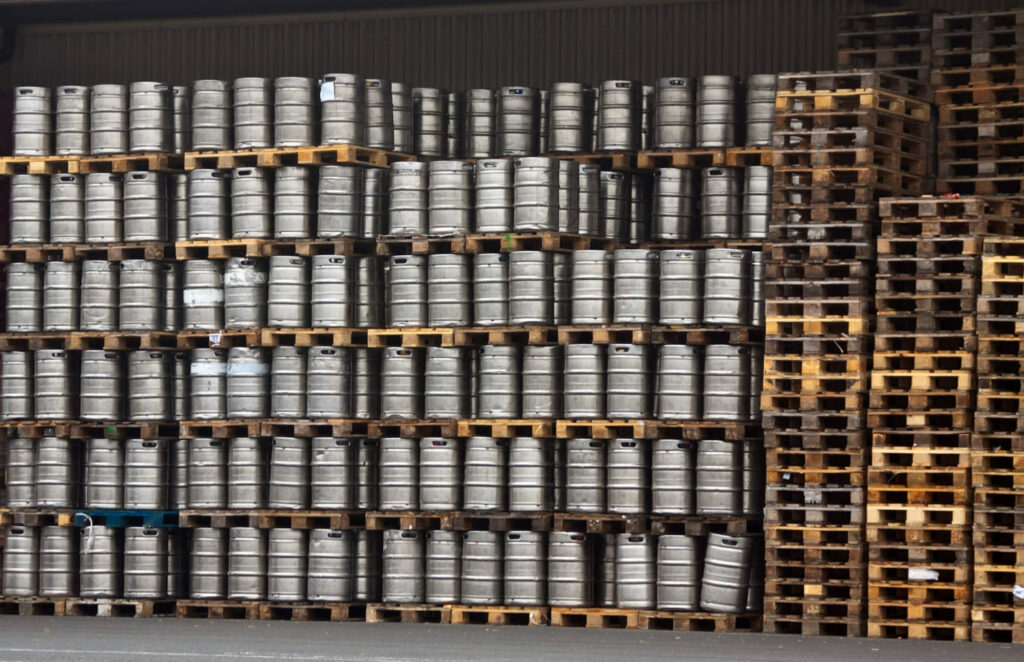
How Much is a Keg?
The price of a keg varies depending on several factors, such as the size of the keg, the brand of beer, and the location. Generally, kegs can cost anywhere from around $50 to several hundred dollars. Some breweries or distributors may require a deposit for the keg, which can be refunded when the keg is returned. Additionally, some retailers may charge a deposit or a tapping fee when you purchase a keg. The total cost of a keg will depend on these factors, so it’s important to research and compare prices before purchasing a keg.
Kegs vs. Bottles and Cans
Kegs, bottles, and cans are all common ways to package and serve beer. Each option has its advantages and disadvantages. Here are some of the factors to consider when choosing between kegs, bottles, and cans:
Advantages of kegs
- Kegs are the most cost-effective option when serving a large group of people.
- Kegs have a higher volume-to-packaging ratio than bottles and cans, which means they are more efficient in terms of transportation and storage.
- Kegs can be reused, making them more environmentally friendly than single-use bottles and cans.
Disadvantages of kegs
- Kegs require additional equipment, such as a tap and CO2 system, to dispense beer, which can be costly and may not be suitable for small-scale events.
- Kegs are heavy and difficult to move, which can be challenging when transporting them to different locations.
- Kegs have a limited shelf life once tapped, which can lead to wastage if not consumed within a certain time frame.
Advantages of bottles and cans
- Bottles and cans are convenient and portable, making them suitable for outdoor events and personal use.
- Bottles and cans have a longer shelf life than kegs once opened, making them more suitable for personal use or smaller events.
- Bottles and cans require less equipment to dispense beer, making them more suitable for small-scale events.
Disadvantages of bottles and cans
- Bottles and cans have a lower volume-to-packaging ratio than kegs, which means they are less efficient in terms of transportation and storage.
- Bottles and cans are single-use, which can lead to environmental waste if not properly recycled.
- Bottles and cans are more expensive per volume than kegs when serving a large group of people.
In terms of cost-effectiveness, kegs are the most cost-effective option when serving a large group of people, while bottles and cans are more suitable for personal use or smaller events. In terms of environmental friendliness, kegs are more environmentally friendly than single-use bottles and cans since they can be reused.
FAQs
What is a keg coupler?
A keg coupler is a device that attaches to the top of a keg and allows the beer to be dispensed through a tap. The coupler connects the keg to the gas and beer lines, and it typically has a valve that regulates the beer’s flow.
How much does it cost to rent a keg?
The cost of renting a keg can vary depending on several factors, such as the size of the keg, the brand of beer, and the location. Generally, kegs can cost anywhere from around $50 to several hundred dollars, and some retailers may charge a deposit or tapping fee.
Can a keg be reused?
Yes, kegs can be reused. Stainless steel kegs are the most commonly reused kegs since they are durable and easy to clean. Kegs can be refilled with new beer after they have been emptied and cleaned.
Can you return an empty keg?
Yes, many breweries and distributors require a deposit for the keg when it is purchased, and the deposit is refunded when the empty keg is returned.
Do you have to drink a keg in one night?
No, kegs do not have to be consumed in one night. The lifespan of beer in a keg can vary depending on the type of beer and storage conditions. Generally, non-pasteurized beer will retain its freshness for 45-60 days, while pasteurized draft beer can last for around 90-120 days.
How long to tap a keg before a party?
It’s recommended to tap a keg at least a few hours before the party to allow the beer to settle and cool properly. Ideally, the keg should be refrigerated for at least 24 hours before tapping.
Can you cold crash beer in the keg?
Yes, beer can be cold crashed in the keg by lowering the temperature to near-freezing to help the yeast and other particles settle to the bottom. This can help clarify the beer and improve its taste.
Is keg beer ruined if it gets warm?
Keg beer is not necessarily ruined if it gets warm, but it can affect the taste and freshness of the beer. It’s important to keep the keg refrigerated and maintain the proper temperature to ensure the best quality and taste.
Why does my keg beer taste bad?
Several factors can cause keg beer to taste bad, such as improper storage and handling, dirty beer lines, and expired beer. It’s important to ensure proper keg maintenance and storage and to clean the beer lines regularly to avoid off-flavors.
Do you turn the gas on before tapping a keg?
Yes, it’s recommended to turn on the CO2 gas before tapping the keg to ensure proper pressure and carbonation of the beer.
Conclusion
In conclusion, the question of how many beers in a keg may seem simple at first glance, but the answer depends on various factors, including keg size, beer size, and average consumption per person. Understanding the intricacies of keg sizes and how to choose the right one for your event or occasion is crucial for a successful gathering.
Additionally, properly storing, maintaining, and tapping a keg can significantly impact the taste and quality of your beer. Whether you’re a beer enthusiast or a casual drinker, knowing the ins and outs of kegs can enhance your beer-drinking experience and impress your friends with your knowledge. So next time you’re planning a party or event, keep these key points in mind and choose the perfect keg size for your occasion.
Keep reading
- How Many Beers In A Case?
- How Many Beers In A Pitcher?
- How Many Ounces In A Can Of Beer?
- How Many Ounces In A Pint Glass?
- How Many Ounces In A Growler?
- How Many Ounces In A Tall Beer?
I’m Chen Mina, from Vol de Nuit, who has a special passion for bartending, especially mixing wine, beer, and cooktail. Here you will find content about alcoholic beverages, I will bring you knowledge that few people know about this drink.

